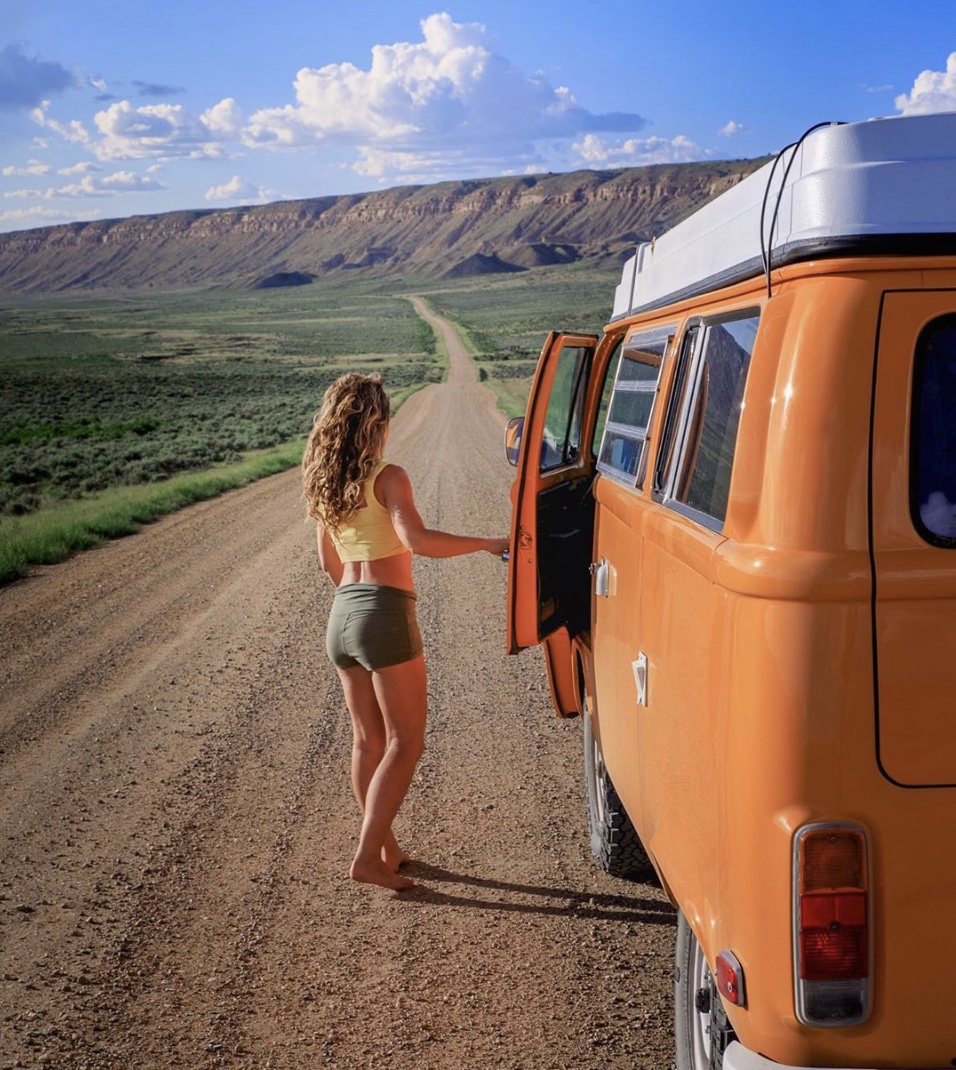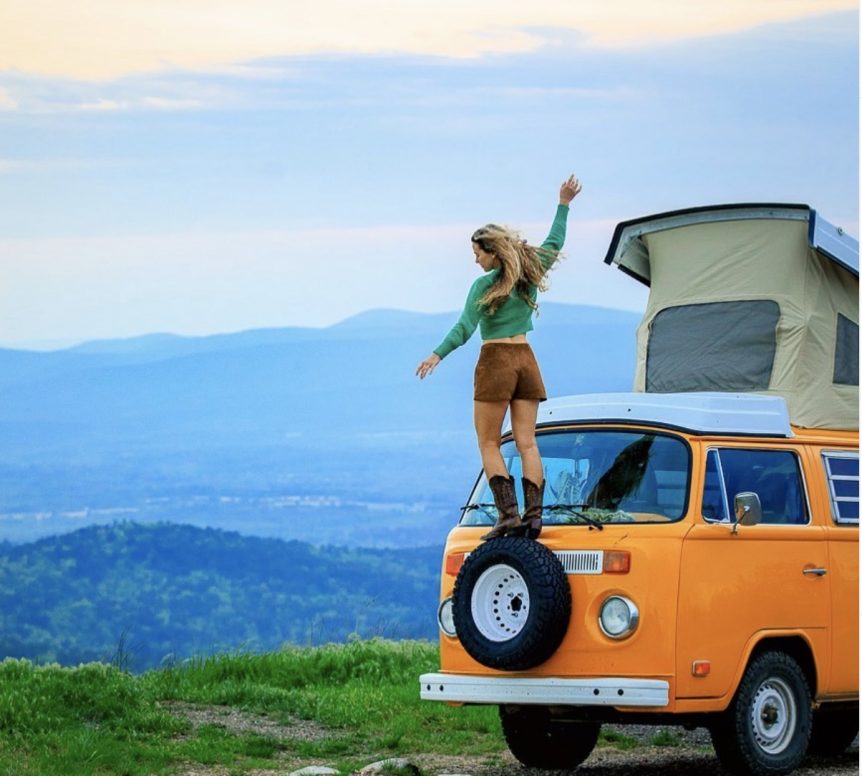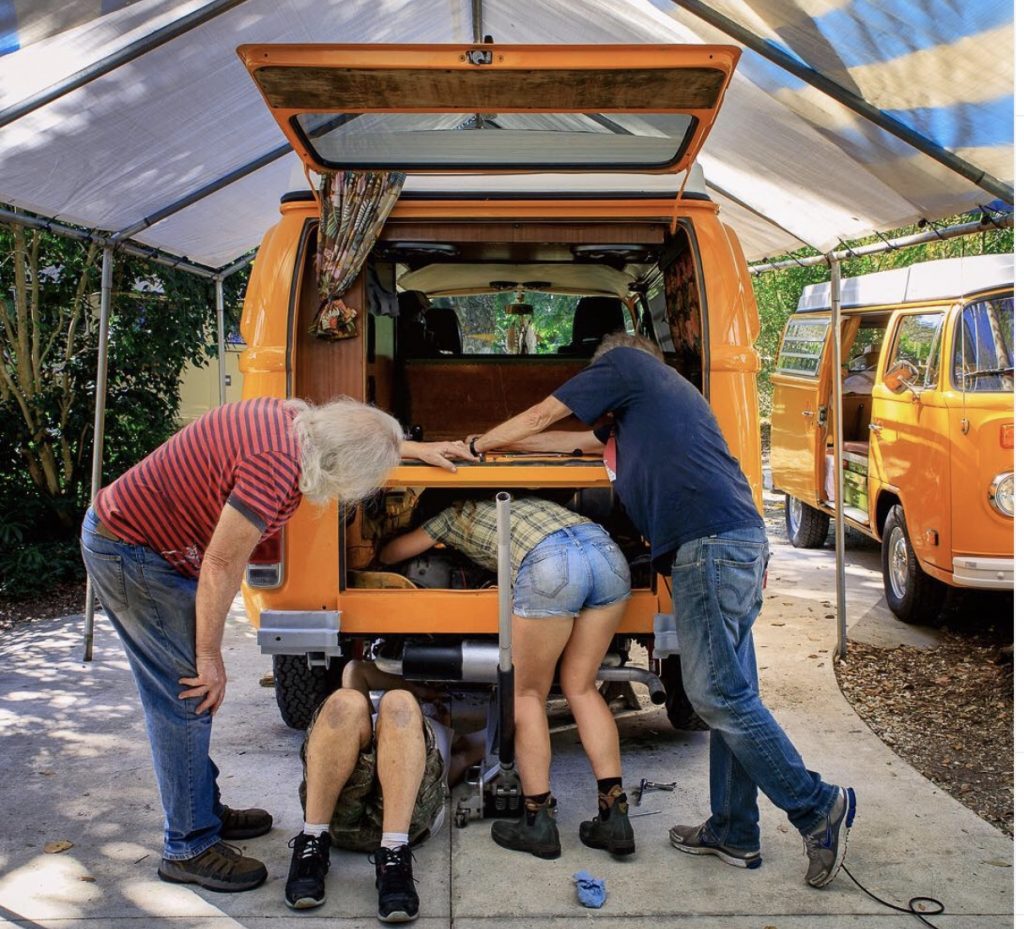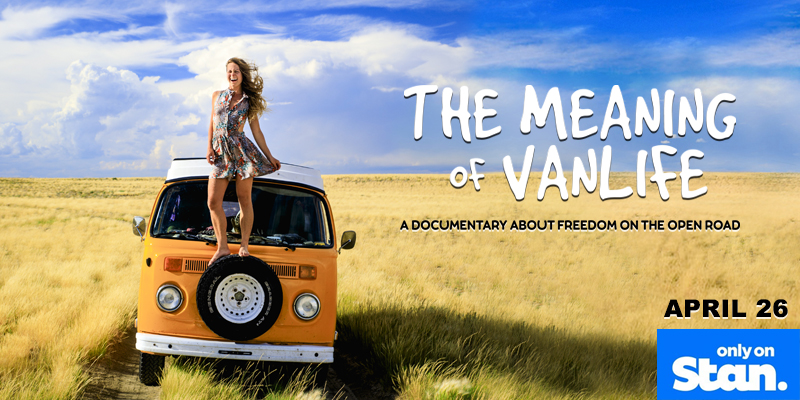“Better to sleep in an uncomfortable bed free, than sleep in a comfortable bed unfree.” – Jack Kerouac.
One of the featured players in the Stan Originals feature documentary “The Meaning of Vanlife” (Jim Lounsbury, Cubic Films, April 26) is the Idle Theory Bus (@idletheorybus), a bright orange van named Sunshine and its owners, Kit Whistler and J.R. Switchgrass, and the charm of their lifestyle and their witty, optimistic selves is contagious.
 The ‘Idle Theory’ they have described in their 150K strong Instagram profile is just that – the theory that they will be more themselves, more at peace with the world, if they self-impose idle time, in solitude and in nature; time doing nothing – idling. They travel the United States, at times working on the land and at many other times, fixing Sunshine.
The ‘Idle Theory’ they have described in their 150K strong Instagram profile is just that – the theory that they will be more themselves, more at peace with the world, if they self-impose idle time, in solitude and in nature; time doing nothing – idling. They travel the United States, at times working on the land and at many other times, fixing Sunshine.
Here Kit, in conversation with the documentary producer Lynnette Lounsbury, discusses her personal and artistic journey and how she felt about being a part of the documentary. Images are by J.R. Switchgrass (@jrswitchgrass).
What is the role of documenting your physical journey play in your own personal journey?
I have an incredibly vivid memory from kindergarten. It was the second day of school and my teacher asked me and my wide-eyed classmates to create a drawing that represented what it was we wanted to be when we grew up. I wrote “Illustrator + Writer” right there on a sheet of yellow-lined paper. I drew a cartoon of my own face concentrating hard. I drew an arrow pointing to my head and wrote “That’s me” on top.
Here’s the thing: for most of my life, I thought I’d invent the worlds I’d write about. I thought I’d concoct short stories and novels and poems that were pure fiction. I always had stories in my head, leftover from dreams and mid-afternoon musings. I’d make up characters who were wild and crazy and free, people I wished I could meet, but who I never thought I’d encounter in the real world. It didn’t occur to me until I was 19 years old that my life could be the story I wrote, or that life in general could be the greatest work of art I ever created. That’s been my goal living on the road: I aim to live a life that would be the most beautiful piece of art I could possibly create. When we headed out of society and onto the road in 2012, that was the aim. To make art of life.
And I can say it the other way around as well: I create art based aro
und my masterpiece of a life. This perpetual physical journey JR and I are on reflects the seeking that occurs in our minds and spirits. For me, documenting our physical travels merely provides a context for the more important exploration—into the dark void of Everything and Nothing. The high altitudes of the mind. You see, I can’t imagine staying in one place very long at all…and yet, I’m happy to wander the path to Everything as long as I live. I find inspiration in our dirt-road camp spots and gas station parking lots at dawn, in the oil-pump fields and the cowtowns, in the ranchers and farmers who employ us. We work their land as we ramble ‘round.
What are your literary and photographic references and inspirations respectively?

I remember reading Walt Whitman for the first time as a 13 year old. I was convinced that he was my best friend. And I was right. He was possibly my only friend. And this persisted. It persists into adulthood. All my close friends were in the pages of books. Still are, for the most part. I’ve always liked the contrarians, the outsiders, the freethinkers. They seemed to function outside of the straight lines and 90-degree angles of society, and that captured me like nothing else did. I always despised the linear nature of traditional society—the hard ground and the harsh edges. The 24-hour-lights and the billboards that scream at you. The “shoulds” and “coulds”, the “I-Have-Tos” that people believe they must endure. I always sought out those who escaped, or at least attempted to break free.
The only people I admire and adore are those who give 1000% to what they do, who show up before a job or a tree or another human being with every ounce of attention and energy they’ve got. It makes me fall in love every time.
My literary inspirations: Richard Braughtigan, because he saw magic and nonsense in the humdrum day-to-day of modern life. Mary Oliver, because she could idle with the best of them. E.B. White, for his economy of words. Kerouac, because he was so tender, so in the moment, so misunderstood because he wrote for TODAY. I admire that. I admire them. I suppose I’d say, in hope and with respect, that they are my peers.
I am also inspired by the natural world, the sunlight between Florida’s ponderosa trees and the cloudy tops of the Cascade mountains and the arid, open land of Idaho. In silence and solitude. I find myself in the blades of grass. I am able to look into the sky and see truth. JR and I, we’ve committed ourselves to space and beauty above all else, and it’s in our audacious goal of a beautiful life that I find the nuggets of Truth I’m compelled to share.
Talk about the heightened nature of your work. It has a clear, optimistic voice and I’d like to know how/why you arrived at that as artists?
All art is heightened right?
Look, what I’m aiming at as an artist is the truth of a moment. And much of truth is emotional, isn’t it? There’s a chapter in our book in which I write about history. We read a text book and we think: “oh, that’s what happened,” in the literal sense. But it’s not true. None of us, not a one, knows what actually happened in the past. The lessons we stand to learn from come from music, paintings, novels, poetry. The sublime. We rely on the emotions of art, on the truth of a piece of music, to guide us to transcendence. History is not heightened, it claims truth, and because of that, it tends to lie more than fiction ever could.
I’d say that there is hope in the act of creation. It’s funny, I find incredible optimism in all art, no matter its inherent message. No matter how bleak a story, how hideous an image, how profane a play, there is beauty to be found within. The artist realized a horrific piece of news about the nature of humanity and chose to gather bare materials and to create in response! Isn’t that a miracle?! The artist doesn’t lie down or watch TV. He makes something new! There is hope in art. There is love in the act of creation. Look at it this way: if you can stare at the deep, dark, disgusting fuck ups of god and the universe and us humans, and still, you care enough to make something to shed light on Truth or shine humour on our shame or alchemize beauty from the sadness, you are an optimist. Yes, that is the gift of optimism. That is the beauty of art. There is comfort for us there.
How does your personal publication world and instant interaction with your audience/readers influence your works?
The instantaneous nature of the artistic platforms we use is sometimes liberating, sometimes suffocating. On the positive end of the spectrum, there’s the thrill of being struck with a spark of inspiration, jotting said idea on proverbial paper (usually typing directly into the notes app of my cell phone), and shooting it directly out into the internet universe: “oh, I made this today. what do you all think about it?” It’s amazing to have that real-time feedback, to know what’s working and what isn’t. That is the good part.
We’re living in interesting times as artists. We have an incredible gift that no generation of makers before us has experienced—direct access to our audience. We have the opportunity to release art daily, without a gatekeeper, a go-between, or a filter. This is a gift, because we have the freedom to create exactly what we want for the people who care about the message.On the other hand, the instantaneous nature of these platforms can be overwhelming. There can be a pressure to connect constantly. The pace of the internet is so fast, and attention is so divided. As an artist, you begin to wonder if nuance and depth are being compromised because of the instant-gratification provided by these platforms…and if you and your work are contributing to the problem.
How do you intertwine creative processes? Do they inform each other? Do you have independent projects? How do you define self amid the ‘together-ness’ of your life and art?
Sometimes it seems as though JR and I communicate with each other best through our art. In a way, we speak to each other as we shoot a photo, or format a page, or as we match a poem of mine with a photo of JR’s. We find extreme togetherness there…And in the silence around us. I find that words are limiting between two people. They can be clumsy tools. In our art, we’ve found an incredible outlet for the passion in our relationship. In creating together, we get to know ourselves as well as each other. Then we get to share that Knowing with the world.
That being said, our lives as well as creative processes have at times been so intertwined that we’ve had lapses in the defining of Self. Sharing 80 square feet of living space, choosing where to go democratically, experiencing 95% of the same events and situations as a single unit….it’s been difficult to find the balance between “Me” and “You”.
Yes, we have independent projects, many of which are being released publicly this year. JR has been shooting a big, ongoing project that he hasn’t shared, coming soon. And I have cartoons and long-form essays coming out under my name. We just began a YouTube channel, and are looking forward to releasing visual projects there together…because we’ll always create together. Always.
How did you find the process of someone else documenting your story instead of you documenting it yourself for The Meaning of Vanlife?
Honestly, it was difficult to let go of control and allow another artist (Jim) to capture our story. We’d held on to our own vision of our lives for so long that it seemed vulnerable to allow someone else to step in and tell it for us. It’s a strange thing, what we do, capturing our own story. What the documentary process made me realize is how much JR and I control our own work (and life). That perhaps I hold onto my freedom of expression so much that I almost lose it. You see, something about freedom is that it requires a lot of discipline…but also a lot of letting go. Filming the documentary was a process of relinquishing power of that control….and we hope our story, as told by the film, is of value to the world in general.
You can find Kit and JR on Instagram under @idletheorybus and in the documentary The Meaning of Vanlife on STAN, Amazon Prime and Itunes.



